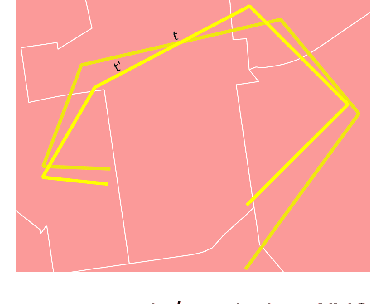Anita Graser
MobilityDL: A Review of Deep Learning From Trajectory Data
Feb 01, 2024Abstract:Trajectory data combines the complexities of time series, spatial data, and (sometimes irrational) movement behavior. As data availability and computing power have increased, so has the popularity of deep learning from trajectory data. This review paper provides the first comprehensive overview of deep learning approaches for trajectory data. We have identified eight specific mobility use cases which we analyze with regards to the deep learning models and the training data used. Besides a comprehensive quantitative review of the literature since 2018, the main contribution of our work is the data-centric analysis of recent work in this field, placing it along the mobility data continuum which ranges from detailed dense trajectories of individual movers (quasi-continuous tracking data), to sparse trajectories (such as check-in data), and aggregated trajectories (crowd information).
Here Is Not There: Measuring Entailment-Based Trajectory Similarity for Location-Privacy Protection and Beyond
Dec 02, 2023

Abstract:While the paths humans take play out in social as well as physical space, measures to describe and compare their trajectories are carried out in abstract, typically Euclidean, space. When these measures are applied to trajectories of actual individuals in an application area, alterations that are inconsequential in abstract space may suddenly become problematic once overlaid with geographic reality. In this work, we present a different view on trajectory similarity by introducing a measure that utilizes logical entailment. This is an inferential perspective that considers facts as triple statements deduced from the social and environmental context in which the travel takes place, and their practical implications. We suggest a formalization of entailment-based trajectory similarity, measured as the overlapping proportion of facts, which are spatial relation statements in our case study. With the proposed measure, we evaluate LSTM-TrajGAN, a privacy-preserving trajectory-generation model. The entailment-based model evaluation reveals potential consequences of disregarding the rich structure of geographic space (e.g., miscalculated insurance risk due to regional shifts in our toy example). Our work highlights the advantage of applying logical entailment to trajectory-similarity reasoning for location-privacy protection and beyond.
Towards eXplainable AI for Mobility Data Science
Jul 17, 2023Abstract:This paper presents our ongoing work towards XAI for Mobility Data Science applications, focusing on explainable models that can learn from dense trajectory data, such as GPS tracks of vehicles and vessels using temporal graph neural networks (GNNs) and counterfactuals. We review the existing GeoXAI studies, argue the need for comprehensible explanations with human-centered approaches, and outline a research path toward XAI for Mobility Data Science.
Federated Learning for Predictive Maintenance and Quality Inspection in Industrial Applications
Apr 21, 2023Abstract:Data-driven machine learning is playing a crucial role in the advancements of Industry 4.0, specifically in enhancing predictive maintenance and quality inspection. Federated learning (FL) enables multiple participants to develop a machine learning model without compromising the privacy and confidentiality of their data. In this paper, we evaluate the performance of different FL aggregation methods and compare them to central and local training approaches. Our study is based on four datasets with varying data distributions. The results indicate that the performance of FL is highly dependent on the data and its distribution among clients. In some scenarios, FL can be an effective alternative to traditional central or local training methods. Additionally, we introduce a new federated learning dataset from a real-world quality inspection setting.
 Add to Chrome
Add to Chrome Add to Firefox
Add to Firefox Add to Edge
Add to Edge